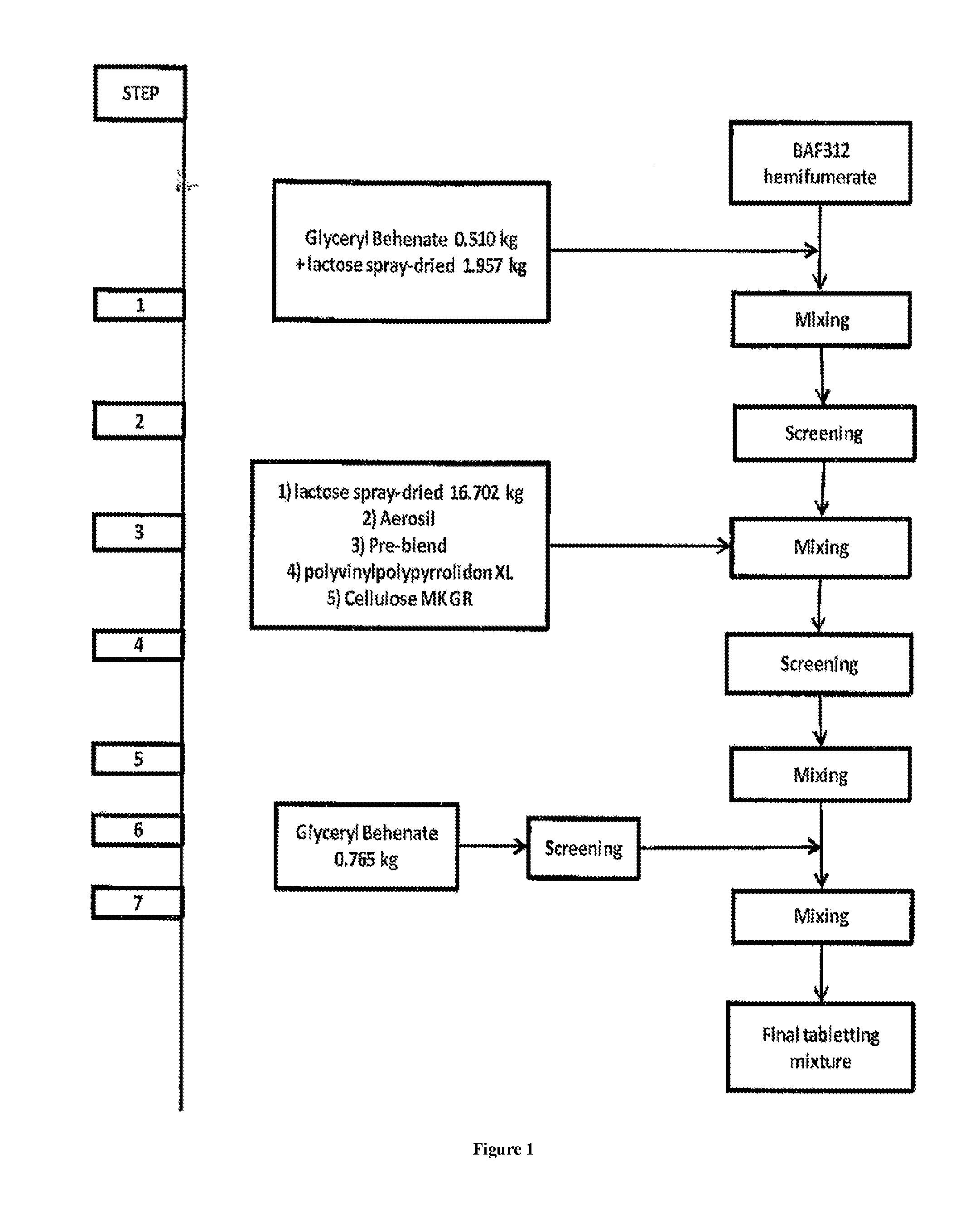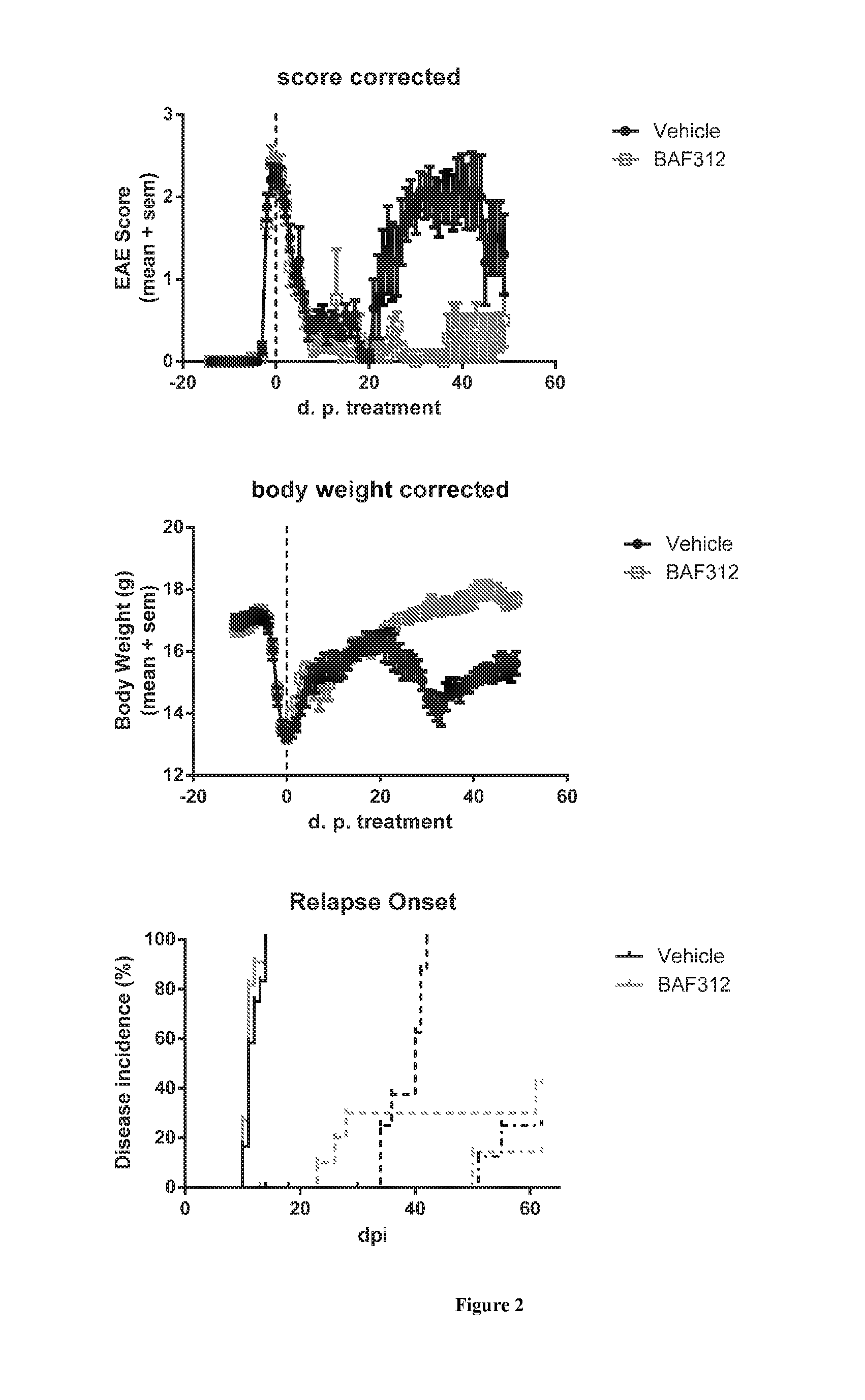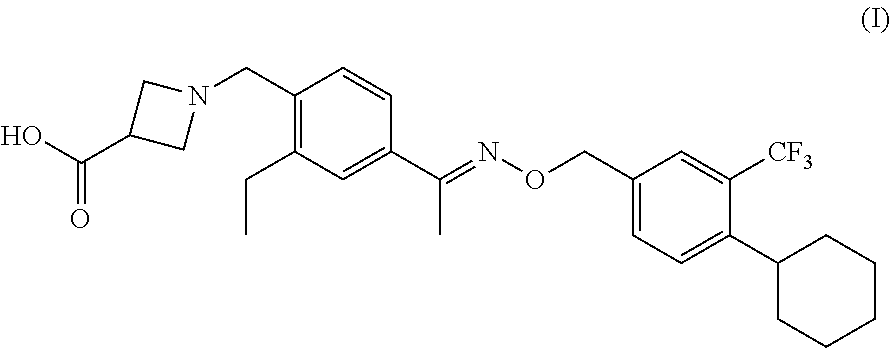Sip modulator immediate release dosage regimen
a technology of sip modulator and immediate release, applied in the field of siponimod, can solve the problems of insufficient recovery, little or no beneficial effect in the progressive stage of disease, and often permanent neurological problems, and achieve the effect of reducing or eliminating symptoms
- Summary
- Abstract
- Description
- Claims
- Application Information
AI Technical Summary
Benefits of technology
Problems solved by technology
Method used
Image
Examples
example 1
Preparation of Immediate Release Tablets
[0206]For the titration / maintenance regimen, 0.25 mg, 0.5 mg, 1 mg and 2 mg siponimod immediate release film-coated tablets can be prepared as described below.
[0207]Process Blending:
[0208]In order to obtain a final mixture ready to be processed to a dosage form, e.g. a tablet, siponimod hemifumarate, e.g. having a X90 value of 18 μm, is blended with different excipients according to the flow diagram of FIG. 1. Therefore, siponimod hemifumarate is pre-blended in step 1 with a mixture of glyceryl behenate as moisture protective agent and spray-dried lactose as filler. The pre-blending is carried out in a diffusion mixer Bohle PM400S (L. B. Bohle Maschinen+Verfahren GmbH, Ennigerloh, Germany) for 10 min at 10 rpm. The mixture of step 1 is then sieved in step 2 using a screening mill having a mesh size of 800 μm. The sieved mixture is then blended in step 3 with further spray-dried lactose as filler, Aerosil as glidant, polyvinylpolypyrrolidon XL ...
example 2
In-Vitro Release of Immediate Release Tablets
[0212]For the dissolution tests, a USP dissolution apparatus 2 (paddle) has been used. The dissolution conditions are summarized in Table 6 below. The dissolution tests has been carried out according to USP “Dissolution”.
TABLE 6Speed of rotation60 ± 2 rpmTest mediumPhosphate buffer pH 6.8 + 0.1% (m / v) Tween 80Volume of test500 mL for the 0.25 mg dosage strengthmedium900 mL for the 0.5, 1 and 2 mg dosage strengthsTemperature37 ± 0.5° C.
[0213]The dissolution rates of the siponimod tablets of Example 1 are summarized in Table 7 below.
TABLE 7DosageDissolution rate [%] afterstrength5 min15 min30 min45 min60 min75 min0.25 mg 34%92%99%100%100%100%0.5 mg 36%91%98%99%99%99%1 mg37%87%97%99%100%100%2 mg50%87%96%98%99%100%
[0214]According to the results in Table 7, the in-vitro release of siponimod is an immediate release.
example 3
Data From Animal Models
Example 3.1
Level of Siponimod in Cerebrospinal Fluid (CSF) in Mice
[0215]Female C57B1 / 6 mice were treated daily with 3 mg / kg BAF312, p.o. for 8 days. 8 hours after the last administration, animals were sacrificed and the levels of BAF312 were measured in blood, brain and CSF.
[0216]Data is summarized in Table 8 below. Shown are mean values of 3-5 animals and standard error of the mean (in brackets).
TABLE 8StrainDosesam-and(mg / kg,plingconc BAF312 (nM) (SEM)speciesqd)daytimeBloodBrainCSFC57Bl / 6388 h973.3 (62.1)5552 (298)7.2 (1) miceC57Bl / 6388 h1600 (79) 9193 (310)17.7 (3.2)mice,EAE
[0217]This shows that a clinically relevant dose of BAF312 (3 mg / kg in mice) leads to exposures in the CSF above the EC50 for S1P1 (0.4 nM) and S1P5 (1 nM).
PUM
 Login to View More
Login to View More Abstract
Description
Claims
Application Information
 Login to View More
Login to View More - R&D
- Intellectual Property
- Life Sciences
- Materials
- Tech Scout
- Unparalleled Data Quality
- Higher Quality Content
- 60% Fewer Hallucinations
Browse by: Latest US Patents, China's latest patents, Technical Efficacy Thesaurus, Application Domain, Technology Topic, Popular Technical Reports.
© 2025 PatSnap. All rights reserved.Legal|Privacy policy|Modern Slavery Act Transparency Statement|Sitemap|About US| Contact US: help@patsnap.com



